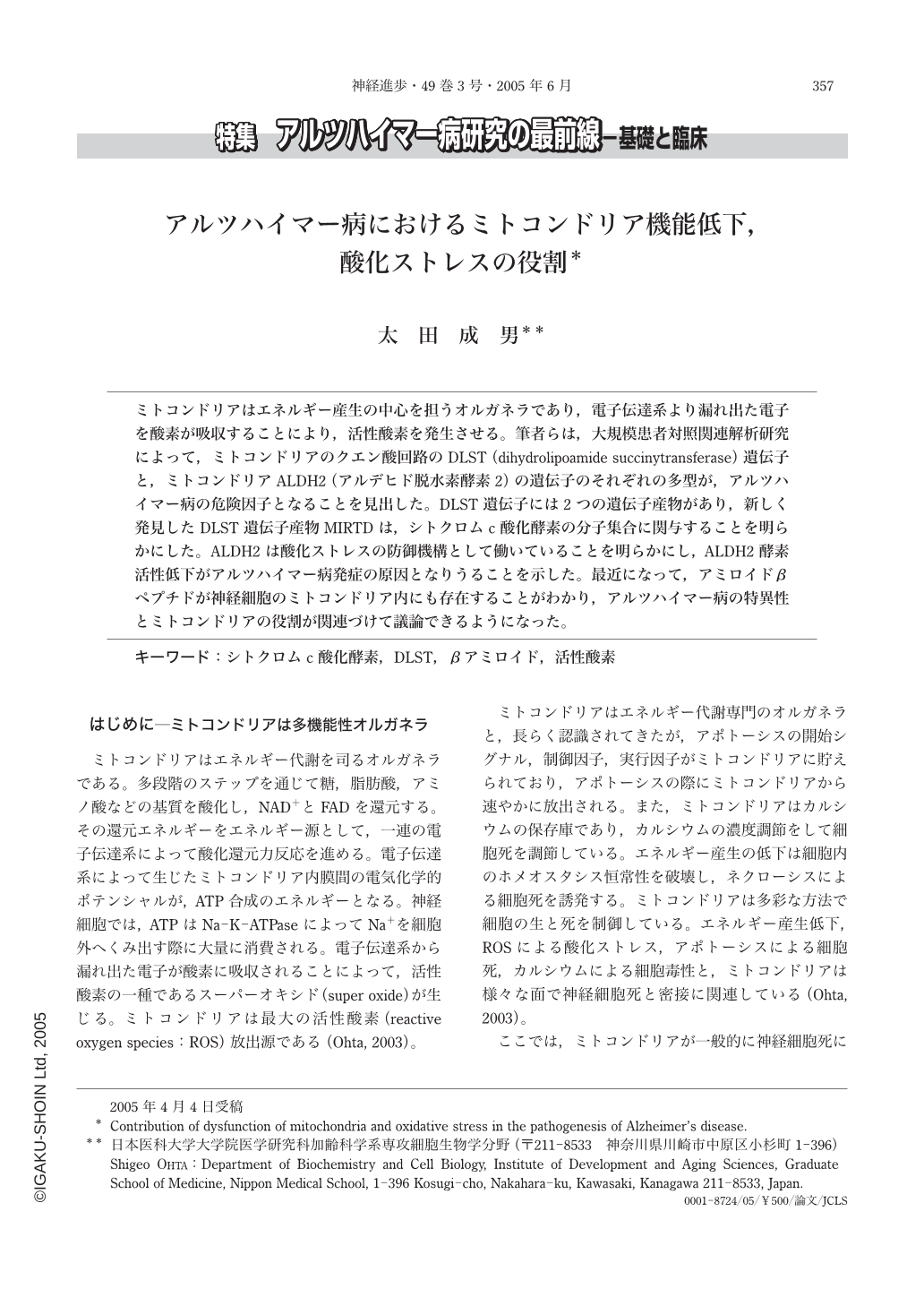Japanese
English
- 有料閲覧
- Abstract 文献概要
- 1ページ目 Look Inside
ミトコンドリアはエネルギー産生の中心を担うオルガネラであり,電子伝達系より漏れ出た電子を酸素が吸収することにより,活性酸素を発生させる。筆者らは,大規模患者対照関連解析研究によって,ミトコンドリアのクエン酸回路のDLST(dihydrolipoamide succinytransferase)遺伝子と,ミトコンドリアALDH2(アルデヒド脱水素酵素2)の遺伝子のそれぞれの多型が,アルツハイマー病の危険因子となることを見出した。DLST遺伝子には2つの遺伝子産物があり,新しく発見したDLST遺伝子産物MIRTDは,シトクロムc酸化酵素の分子集合に関与することを明らかにした。ALDH2は酸化ストレスの防御機構として働いていることを明らかにし,ALDH2酵素活性低下がアルツハイマー病発症の原因となりうることを示した。最近になって,アミロイドβペプチドが神経細胞のミトコンドリア内にも存在することがわかり,アルツハイマー病の特異性とミトコンドリアの役割が関連づけて議論できるようになった。
Mitochondrion is a multifunctional organelle. Apoptosis as well as necrosis is closely related with mitochondrial functions. Damage to mitochondria causes a decline in ATP synthesis and an increase in the generation of reactive oxygen species(ROS). ROS damage various molecules including DNA, protein and lipid and induce apoptosis. Evidence has recently emerged that oxidative stress is involved in the pathogenesis of Alzheimer's disease(AD). Moreover, it has been shown that amyloid β peptide is involved in enhancing oxidative stress.
Here, the author focus on the involvement of dysfunction in mitochondria with AD and review recent approaches to the molecular pathogenesis of AD.
First, the author would like to describe the involvement of deficiency of molecular assembly of cytochrome c oxidase(COX). Dihydrolipoamide succinyltransferase(DLST)is a subunit-enzyme of theα-ketoglutarate dehydrogenase complex of the Krebs cycle. While studying how the DLST genotype contributes to the pathogenesis of AD, we found a novel mRNA that is transcribed starting from intron 7 in the DLST gene. The novel mRNA level in the brain of AD patients was significantly lower than that of controls. The truncated gene product(designated MIRTD)localized to the intermembrane space of mitochondria. To investigate the function of MIRTD, we established human neuroblastoma SH-SY5Y cells expressing a maxizyme, a kind of ribozyme, that specifically digests the MIRTD mRNA. The expression of the maxizyme specifically eliminated the MIRTD protein and the resultant MIRTD-deficient cells exhibited a marked decrease in the amounts of subunits of the COX complex of the mitochondrial respiratory chain, resulting in a decline of activity. A pulse-label experiment revealed that the loss of the subunits is a post-translational event. Thus, the DLST gene is bifunctional and MIRTD transcribed from the gene contributes to molecular assembly of the mitochondrial respiratory complex, including COX.
Second, the author review on oxidative stress caused by a deficiency of mitochondrial algehyde dehydrogenase 2(ALDH2). ALDH2 is involved in ethanol metabolism by playing a major role in acetaldehyde detoxification. A polymorphism of the ALDH2 gene is specific to north Asians. Sensitivity to ethanol is highly associated with this polymorphism(ALDH2*2 allele), which is responsible for a deficiency of ALDH2 activity. We at first show that this deficiency influences the risk for late-onset Alzheimer's disease(LOAD)by a case-control study in a Japanese population. In a comparison of 447 patients with sex, age and region-matched non-demented controls, the genotype frequency for carrying the ALDH2*2 allele was significantly higher in the patients than in the controls(p=0.001). Next, we examined the combined effect of the ALDH2*2 and apolipoprotein E 4 allele(APOE-ε4), which has been confirmed to be a risk factor for LOAD. The ALDH2*2 allele more significantly affected frequency and onset-age in patients with APOE-ε4 than without. These results indicate that the ALDH2 deficiency is a risk factor for LOAD, acting synergistically with the APOE-ε allele. Next, to elucidate the molecular mechanism involved, we obtained ALDH2-deficient cell lines by introducing mouse mutant Aldh2 cDNA into PC12 cells. We speculate that ALDH2 may function to oxidize toxic aldehyde derivatives. Then, we found that the ALDH2-deficient transfectants were highly vulnerable to exogenous 4-hydroxy-2-nonenal, an aldehyde derivative generated from peroxidized fatty acids. In addition, the ALDH2-deficient transfectants were sensitive to oxidative insult induced by antimycin A, accompanied by an accumulation of proteins modified with 4-hydroxy-2-nonenal. Mitochondrial ALDH2 functions as a protector against oxidative stress.
Finally, the author would like to review on the direct involvement of Aβ with mitochondrial dysfunctions, through inhibition of COX activity and enhancement of oxidative stress via Aβ-binding alcohol dehydrogenase(ABAD) which is located in mitochondria.

Copyright © 2005, Igaku-Shoin Ltd. All rights reserved.


